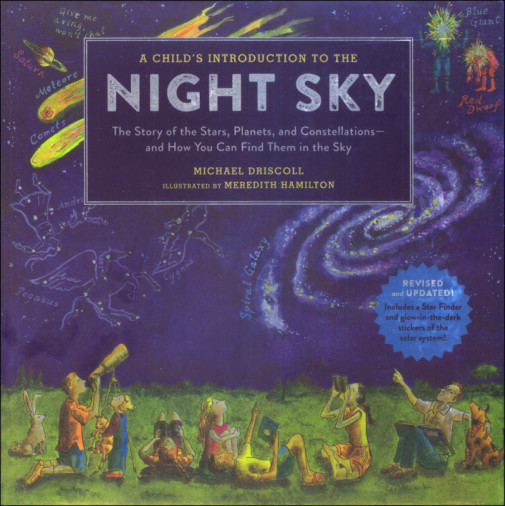We use cookies to make your experience better. To comply with the new e-Privacy directive, we need to ask for your consent to set the cookies. Learn more.
Child's Introduction to the Night Sky
The author, Michael Driscoll, has packed a lot of information into this 95 page, hardcover book. Cute illustrations and drawings by Meredith Hamilton, magnificent photography, and a great deal of astronomy material fill the pages. The book is divided into three sections: Our Universe and Welcome to It, What’s Up There, and Exploring What’s Up There. The first section gives an overview of what’s in the night sky and information about the universe in general, including the believed age of 15 billion years. “What’s Up There” talks about the stars, sun, planets, asteroids, comets, galaxies, gravity, dark matter, black holes and neutron stars. Exploring What’s Up There includes tools for star gazers, traveling to the stars, astronauts, space station, constellations and looking at the sky in each season. This last section includes information about the Zodiac and its role in astrology. A brief history of space is included at the end, along with a guide for finding things in the night sky.
You can get some experience finding constellations by using the Star Finder included with the book. Take it outside with you as you star gaze and use it to locate the night time formations. Glow-in-the-dark stickers are also included. Planets, stars, and more can be used to bring the night sky into your room. ~ Donna
A Child's Introduction to the Night Sky is the perfect introduction to the always fascinating world of astronomy. Children ages eight and up will find out what astronomers have learned (and are still discovering), what astronauts and scientists explore, and what they can find by gazing up into the sky at night.
Author Michael Driscoll explains how stars are born, the achievements of the great scientists, the history of space exploration, the story of our solar system, the myths behind the constellations, how to navigate the night sky, and more.
Whimsical color illustrations throughout and handy definitions and sidebars help engage younger readers and develop their interest. Also included are a nifty star finder tool and fun glow-in-the-dark stickers.
| Product Format: | Hardcover |
|---|---|
| Brand: | Black Dog and Leaventhal |
| Author: | Michael Driscoll |
| Grades: | 3-AD |
| ISBN: | 9780762495504 |
| Length in Inches: | 10.25 |
| Width in Inches: | 10.5 |
| Height in Inches: | 0.5 |
| Weight in Pounds: | 1.75 |

